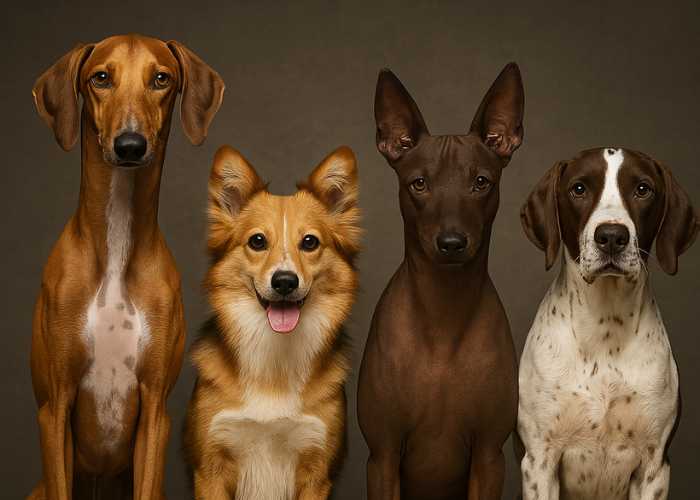Have you ever wondered how your dog sees the world? The way dogs perceive their surroundings is a mystery that has puzzled owners and experts for centuries.
Although they don’t see the world exactly like we do, dogs’ vision is incredibly adapted to their needs, allowing them to be agile hunters, loyal companions and attentive protectors.
In this article, we’ll delve into the fascinating world of canine vision. You’ll discover how they see colors, why they’re masters at detecting movement, and how their night vision is far superior to ours. We’ll also explore interesting facts that will change the way you interact with your four-legged friend.
How Does Canine Vision Work?
Dogs’ vision is a reflection of their evolution as hunters. While we humans rely on vibrant colors and detail to navigate the world, dogs have vision optimized for survival, especially in low-light conditions.
1. Field of View
Dogs’ eyes are positioned differently than ours, giving them a wider field of vision, around 250 degrees, compared to around 190 degrees for humans. This means they can perceive movement to the sides much more effectively. However, this advantage comes at a cost: their depth perception is less accurate.
2. Color Vision
Contrary to the myth that dogs see in black and white, they actually see the world in shades of blue, yellow and gray. This is because they have two types of cones in their eyes (we have three). Colors like red and green are indistinguishable to them, appearing as shades of gray.
3. Night Vision
If you’ve ever seen your dog’s eyes glow in the dark, it’s because of the tapetum lucidum, a structure that reflects light inside the eye, amplifying their night vision. This ability is essential for nocturnal hunters and allows them to detect movement in low-light conditions.
4.Motion Sensitivity
Dogs are experts at detecting movement, even from a distance. This ability is crucial for identifying prey or imminent danger. As a result, you may notice that your dog reacts to subtle movements that you might not notice.
Differences Between Canine and Human Vision
| Aspect | Humans | Dogs |
|---|---|---|
| Field of view | 190 degrees | 250 degrees |
| Color perception | Trichromatic (RGB) | Dichromatic (blue and yellow) |
| Night vision | Moderate | Excellent |
| Motion detection | Good | Excellent |
Why is Dog Vision Different?
A visão canina é moldada pela evolução. Os ancestrais dos cães precisavam de habilidades visuais específicas para caçar e sobreviver em ambientes selvagens. A capacidade de enxergar no escuro, detectar movimentos sutis e ter um campo de visão mais amplo foi crucial para sua sobrevivência.
Today, even domesticated dogs retain these abilities. They may not see the world in the same rich detail as we do, but their eyes are powerful tools for exploring their surroundings, identifying dangers, and connecting with their owners.
Interesting Facts About Canine Vision
- Preference for Blue and Yellow
Toys in these colors are more attractive to dogs, as they can easily identify them. - They Recognize Their Owner by Smell
Although they can recognize familiar faces, dogs rely more on their sense of smell to identify people. - “Blurred” Vision Up Close
Dogs have difficulty focusing on objects that are too close, so they can use their sense of smell to complement their vision in these cases. - Night Blindness in the Elderly
As dogs age, they develop vision problems, such as cataracts, which especially affect their night vision. - They See Better in Motion
Stationary objects may be harder to spot, but fast movements catch your attention instantly.
Como Melhorar a Experiência Visual do Seu Cão?
1. Escolha Brinquedos Nas Cores Certas
Keep furniture layout consistent, especially for older dogs or dogs with vision problems.
2. Evite Mudanças Bruscas no Ambiente
Keep furniture layout consistent, especially for older dogs or dogs with vision problems.
3. Estimule a Visão com Atividades
Games that involve movement, such as fetching balls, help keep your dog’s vision active and healthy.
4. Consulte o Veterinário Regularmente
Problems like cataracts and glaucoma are common in older dogs. Regular checkups are essential to prevent complications.
Conclusion
Dogs’ vision is a fascinating universe that reflects their evolution and needs as hunters and companions. Although they see the world differently than we do, their abilities are perfectly adapted to offer protection, explore the environment and connect with us.
By understanding how dogs perceive the world, we can improve our communication with them, offering more attentive care and activities that stimulate their natural abilities. After all, the more we know about our four-legged friends, the deeper the relationship we share becomes.
Frequently Asked Questions
1. Do dogs see in black and white?
No. They see in shades of blue, yellow and gray, but they cannot distinguish between red and green.
2. Why do dogs’ eyes glow in the dark?
This is due to the tapetum lucidum, a structure that reflects light and improves your night vision.
3. How do I know if my dog has vision problems?
Signs include frequent tripping, hesitation when walking in new environments, and difficulty finding objects.
4. Do dogs recognize people by sight?
Yes, but they rely more on smell and hearing to identify individuals.
5. Is it possible to improve my dog’s vision?
Although we cannot change a dog’s vision, maintaining regular veterinary check-ups and adapting the environment helps to preserve their eye health.



